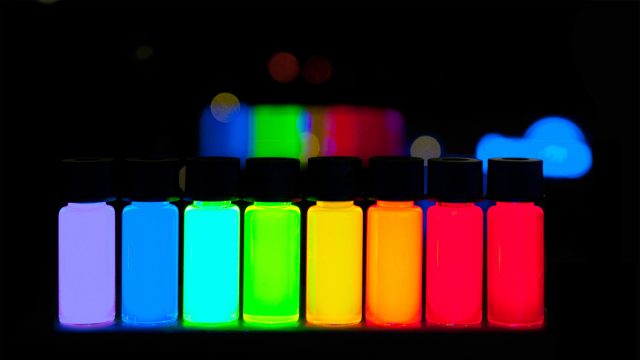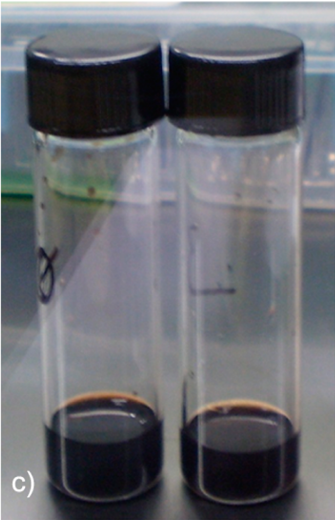Darker than black quantum dots

A quantum dot is a nanometric crystalline structure of semiconductor materials. In a quatum dot electrons are confined in a region of space, thus creating a well defined structure of energy levels that depends very much on the size and shape of the quantum dot. This structure resembles that of atoms, that is why sometimes quantum dots are also called artificial atoms.
We can not create a real atom to have some interesting optoelectronic characteristics of our choice; but what we can certainly do is designing a quantum dot through composition, shape and size to have almost any electronic structure with an interaction with light of our convenience. This control of the light that quantum dots can emit or absorb makes them key systems to be used in laser diodes, photovoltaic cells or biomedical optical markers, to name just a few applications.
But quatum dots are not used in a vacuum. They must be integrated into different systems, and this implies that whatever is around the quantum dot may affect its electronic energy levels and, therefore, its optical properties. Not only that, the interaction with the molecules in the environment could alter chemically the quantum dot, again destroying its valuable properties. In the case of liquid processing, where quantum dots are dispersed into a colloidal suspension, they must be passivated, often using organic ligands, introduced during the quantum dot synthesis to control nucleation and growth, to remove unsaturated valences.

This passivating ligands are generally insulating long-chain aliphatic compounds (like oleic acid) and they must be replaced with shorter molecules in order to integrate quantum dots in efficient optoelectronic devices. But this is easier said than done. In the case, for example, of the combination of lead with the elements of the family of oxygen (lead chalcogenides) the substitution with shorter ligands is a limitating factor because of the tendency of this compounds to undergo oxidation, coalescence and aggregation when you try it.
Carlo Giansante, from the Istituto Italiano di Tecnologia, and collaborators recently proposed a PbS (lead sulfide) quantum dot surface modification strategy that guarantees complete replacement of the oleate ligands with shorter ones, preserving good long term colloidal stability in the solvents commonly used for the deposition of quantum dots into smooth dense packed thin films.
Now a team of researchers, including Carlo Giansante and Ivan Infante from the Kimika Facultatea (UPV/EHU) and DIPC, have used 1this approach to describe the effects of replacing ligands on the optical absortion properties of colloidal quantum dots. As a result they provide a novel path in the design of light harvesting nanomaterials, which could find applications in photovoltaic and photodetection devices.

Organic ligands at the nanocrystal surface generally comprise an anchoring group, which is bound to the metal sites of the quantum dot removing unsaturated valences, and a external part (a pendant moiety) which is in contact with the surroundings and ensures the quantum dot colloidal stability (see Figure 3). What the researchers have done is to use a para-methylbenzenethiolate ligand as a framework. In this ligand, where the substituting groups are at opposite positions (para-) in a benzene ring, the methyl acts as the pendant moiety and the thiolate as the anchoring group. The scientists have modified systematically this framework replacing the ligand subunits: testing electron accepting or donating subtituents as pendant moieties while keeping the thiolate anchoring group, and keeping the methyl pendant moiety and introducing anchoring groups that differ in their chemical nature and bonding mode.

What they find is a broadband enhancement of the optical absorption of colloidal PbS quantum dots . This enhancement is induced by the thiolate ligands, which can be tuned above 300%, thus making the black PbS darker than black. Organic ligands and inorganic cores in a quantum dot are inherently electronically coupled materials. What the researchers show is the prominent role exerted by the chemical nature and coordination geometry of the anchoring group and its π conjugation with the pendant moiety, which is what mediates the coupling with the PbS cores.
These findings may result in a simple and effective approach to enhance and tune broadband solar-light absortion that could lead to the design of more efficient light harvesting systems.
Author: César Tomé López is a science writer and the editor of Mapping Ignorance.
References
- Giansante C., Ivan Infante, Eduardo Fabiano, Roberto Grisorio, Gian Paolo Suranna & Giuseppe Gigli (2015). “Darker-than-Black” PbS Quantum Dots: Enhancing Optical Absorption of Colloidal Semiconductor Nanocrystals via Short Conjugated Ligands, Journal of the American Chemical Society, 137 (5) 1875-1886. DOI: http://dx.doi.org/10.1021/ja510739q ↩
1 comment
[…] Posible ote da beltza den zerbait hiru aldiz beltzako bihurtzea? Agian bai, DIPCkoek (Donostia International Physics Center) magia egiten baitute: Darker than black quantum dots. […]